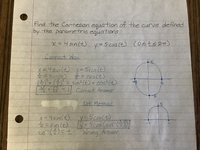I understand that to convert parametric equations into a Cartesian equation, we can solve for the third variable (in this case; t) in terms of x and then plug that into the other equation thus giving you an equation with only x and y as the variable.
However for this particular question, because trigonometric functions are involved there is another way to convert the parametric equations into a Cartesian equation. I understand how to solve for the answer but I just don’t understand why the first method doesn’t also yield the correct answer. I have taken a picture of the question with my work below.
Thank you very much!
However for this particular question, because trigonometric functions are involved there is another way to convert the parametric equations into a Cartesian equation. I understand how to solve for the answer but I just don’t understand why the first method doesn’t also yield the correct answer. I have taken a picture of the question with my work below.

Thank you very much!
